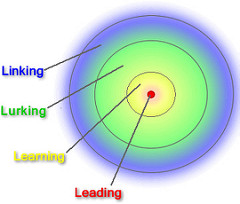ATD Blog
Roles in CoP's
Sun Jun 11 2006

In my role as blogmeister for LCB I've done a lot of reading in the communities of practice literature to gain a better understanding of how online communities work. What can be done to enhance the community? What causes high quality interaction or community disfunction and collapse.
One model I've developed is around the roles and interactions members of a community have as participants in that community. I thought I'd share my model with the LCB community for feedback and discussion. My 4L Model (Linking, Lurking, Learning, Leading) was spawned by comments made by John Seeley Brown in an interview with Marcia Connors for LineZine.Further influence came from the work of Lave, Wenger and McDermott.
The graphic to the right demonstrates the four types of roles in an online community. Any prospering community will have participants in each of these roles. Note that the lines between the roles are blurred. What role a participant is playing in the community is both determined and defined by the participant. Thus, it is not possible to strictly define the roles. In fact, any one participant can simultaneously play different roles on different topics within the same community. (ie, the leader of an organization often becomes a linking participant to areas they previously may have not paid attention to.)
While the roles can't be strictly defined, they do have basic characteristics which can be identified.
Linking These are visitors who find a community by one means or another. They may have have bookmarked the site or added it to their RSS reader. They are in a "testing" mode to determine if this community if of interest to them and worth giving more of the time and attention.
Lurking Often the largest segment of a community, these individuals pay attention to the activity of the group and occasionally participate in various activities. Wenger calls this group Legitimate Peripheral Participants (LPP). They may be interested in greater involvement, but either don't feel worthy or don't know how. For others the content may only be peripheral to their work.
Learning These are regular visitors who contribute to the community regularly. They are considered "members" of the community. Occasionally , they may take on a project or event leadership role as either an "audition" for a more core role or as a way to lead despite overall time unavailability.
Leading At the core of a community are the Leaders of that community. Leadership is a matter of commitment and willingness to contribute on a consistent basis. Leaders may or may not be designated via title. Roles, other than community coordinator, may evolve as needed. Wenger says it is the responsibility of leadership to "build a fire" of activity that is strong enough to draw people to the community and encourage greater participation.
Movement from one role to another is a learning process in which participants encourage and model roles for each other in what Seeley Brown refers to as a cognitive apprenticeship. Thus it's incumbent upon the community to provide opportunities for participants to learn from each other and to "try on" new roles.
So what do you think? Does this make sense? I'm curious what the LCB community thinks as to how well LCB tends to the various roles in our community. Are we a community? Should we be?
technorati tags:communities of practice, CoP roles, CoP's
You've Reached ATD Member-only Content
Become an ATD member to continue
Already a member?Sign In
